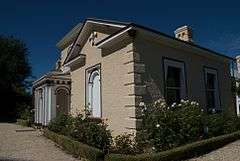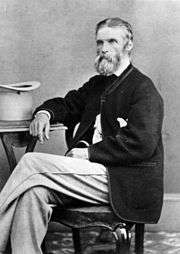Woolmers Estate
| Woolmers Estate | |
|---|---|
 The front entrance of the Woolmers main house. | |
| General information | |
| Architectural style | Italianate |
| Address | Woolmers Lane, Longford TAS 7301 |
| Town or city | Longford, Tasmania |
| Country | Australia |
| Construction started | 1819 |
| Completed | 1843 |
| Owner | Woolmers Foundation Inc. |
| Design and construction | |
| Architect | William Archer |
| Website | |
|
woolmers | |
| Type | Cultural |
| Criteria | iv, vi |
| Designated | 2010 (34th session) |
| Part of | Australian Convict Sites |
| Reference no. | 1306 |
| State Party |
|
| Region | Asia-Pacific |
Woolmers Estate is farming estate located in Longford, Tasmania, founded in 1817[1] by prominent grazieer and member of parliament Thomas Archer. It consists of an 82ha property, including a two-part manor house, coach house, the National Rose Garden, extensive outbuildings and convict cottages and formal gardens. The main house consists of a brick nog weatherboard homestead, built in 1819, with an attached extensive addition in Italiate style, designed by William Archer and built in 1842-1843.[2]
One of the two main ancestral homes of the Archer family, Woolmers was World Heritage listed as part of the Australian Convict Sites together with Brickendon Estate in 2010.[3] It is also listed on the Tasmanian Heritage Register [2] and the Australian National Heritage List since 2007.[4][5]
Name
Like most Archer properties, Woolmers was named after an English location or building - Woolmer's Park, in Hertforshire.[6]
National Rose Garden
The Woolmers Estate features the National Rose Garden, which was begun in 1999 and fundraised by public donation. It has 460 varieties of rose,[7] and over 5000 individual plants.[8]
History

In 1812, Thomas Archer arrived in New South Wales on the ship Guilford, with a letter of introduction from Lord Liverpool[9] acquired from the influence of his uncle, proprietor of the London Courier. He achieved success as a public servant, starting as a Clerk in the Sydney Commissariat before being appointed acting deputy assistant commissary in November of that year. He was transferred to Port Dalrymple (modern George Town) as clerk in charge, in 1813. He was made magistrate in 1814 and coroner of Cornwall County in 1816. He married his wife Susan Hortle the same year. Various other promotions followed but he retired in 1821 to focus on his farm.[10] In 1817, he had been granted 800 acres, which formed the core of his Woolmers Estate. By 1819, the very first part of modern Woolmers - the weatherboard section of the main house - was under construction, using wood logged on the property.[9]
References
- ↑ "Closure spectre hangs over Woolmers Estate". The Examiner. 21 June 2012. Retrieved 27 September 2014.
- 1 2 "Tasmanian Heritage Register Entry - Woolmers Estate" (PDF). heritage.tas.gov.au. Tasmanian Heritage Council. Retrieved 27 September 2014.
- ↑ "Australian Convict Sites". whc.unesco.org. UNESCO World Heritage Committee. Retrieved 4 October 2014.
- ↑ "National recognition for two Tas colonial homesteads". The Australian Broadcasting Corporation. 24 November 2007. Retrieved 27 September 2014.
- ↑ "National Heritage Places - Woolmers Estate". environment.gov.au. Department of Environment, Commonwealth of Australia. Retrieved 28 September 2014.
- ↑ "Thomas Archer - the settler circa 1817-1850". woolmers.com.au. Woolmers Foundation. Retrieved 28 September 2014.
- ↑ "Old Vegies". Australian Broadcasting Corporation. 9 December 2005. Retrieved 27 September 2014.
- ↑ Francis, Liz (2013). Gorgeous gardens of Tasmania ... an island odyssey (1st ed.). p. 74. ISBN 978-0-9875897-9-8.
- 1 2 Trusts, Australian Council of National (1969). Historic homesteads of Australia Vol I. Stanmore, N.S.W.: Cassell Australia/Australian Council of National Trusts. pp. 16–21. ISBN 0726900001.
- ↑ "Archer, Thomas (1790–1850)". adb.anu.edu.au. Australian Dictionary of Biography. Retrieved 5 October 2014.